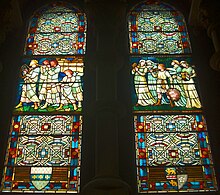The year 1863 in architecture involved some significant architectural events and new buildings.

Saint Fin Barre's Cathedral is a Gothic Revival three-spire Church of Ireland cathedral in the city of Cork. It is located on the south bank of the River Lee and dedicated to Finbarr of Cork, patron saint of the city. Formerly the sole cathedral of the Diocese of Cork, it is now one of three co-cathedrals in the United Dioceses of Cork, Cloyne and Ross in the ecclesiastical province of Dublin. Christian use of the site dates back 7th-century AD when, according to local lore, Finbarr of Cork founded a monastery. The original building survived until the 12th century, when it either fell into disuse or was destroyed during the Norman invasion of Ireland. Around 1536, during the Protestant Reformation, the cathedral became part of the established church, later known as the Church of Ireland. The previous building was constructed in the 1730s, but was widely regarded as plain and featureless.

William Burges was an English architect and designer. Among the greatest of the Victorian art-architects, he sought in his work to escape from both nineteenth-century industrialisation and the Neoclassical architectural style and re-establish the architectural and social values of a utopian medieval England. Burges stands within the tradition of the Gothic Revival, his works echoing those of the Pre-Raphaelites and heralding those of the Arts and Crafts movement.

Hardman & Co., otherwise John Hardman Trading Co., Ltd., founded 1838, began manufacturing stained glass in 1844 and became one of the world's leading manufacturers of stained glass and ecclesiastical fittings. The business closed in 2008.
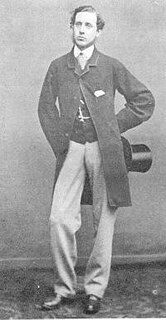
Charles Eamer Kempe was a Victorian era designer and manufacturer of stained glass. His studios produced over 4,000 windows and also designs for altars and altar frontals, furniture and furnishings, lichgates and memorials that helped to define a later nineteenth-century Anglican style. The list of English cathedrals containing examples of his work includes: Chester, Gloucester, Hereford, Lichfield, Wells, Winchester and York. Kempe's networks of patrons and influence stretched from the Royal Family and the Church of England hierarchy to the literary and artistic beau monde.
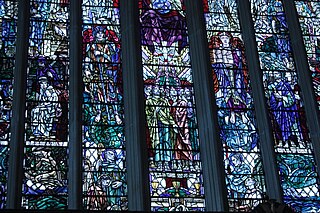
Douglas Strachan is considered the most significant Scottish designer of stained glass windows in the 20th century. He is best known for his windows at the Peace Palace in The Hague, Netherlands, at Edinburgh's Scottish National War Memorial and in cathedrals and churches throughout the United Kingdom. He is also known for his paintings, murals, and illustrations.

Christopher Whitworth Whall was a British stained-glass artist who worked from the 1880s and on into the 20th century. He is widely recognised as a leader in the Arts and Crafts Movement and a key figure in the modern history of stained glass.

The Glass House building was a "purpose-built stained-glass studio and workshop" for stained glass artists in Fulham, London. Having gone into partnership in 1897, Mary Lowndes and Alfred Drury had The Glass House built in 1906 for use by independent stained-glass artists.
Edward Woore or Davie Woore (1880–1960) was a British stained glass artist and member of the British Society of Master Glass Painters. He was a student, apprentice and collaborator with Christopher Whall, a stained glass artist and leader in the Arts and Crafts Movement.

Holy Trinity Church, Templebreedy is a parish church of the Church of Ireland close to Crosshaven, in County Cork, Ireland. It was designed by William Burges, who also designed Saint Fin Barre's Cathedral. The building opened in 1868 and remains an active parish church.
Cox & Barnard Ltd was a stained glass designer and manufacturer based in Hove, part of the English city of Brighton and Hove. The company was founded in Hove in 1919 and specialised in stained glass for churches and decorative glass products. Many commissions came from Anglican and Roman Catholic churches in the English counties of East Sussex, West Sussex and Kent. The company was also responsible for six war memorial windows at an Anglican church in Canada, made from shards of glass collected from war-damaged church windows across Europe.

Carrigrohane is a village and civil parish situated on the south bank of the River Lee to the west of the city of Cork in Ireland. It is connected by the Carrigrohane Straight, 4 miles (6.4 km) west of Cork and is also in the northeastern part of Ballincollig. It contains St Peter's Church of the Resurrection. In 1837, it had a population of 1921 inhabitants. The civil parish is almost evenly split between the baronies of Muskerry East to the west and the Barony of Cork to the east.
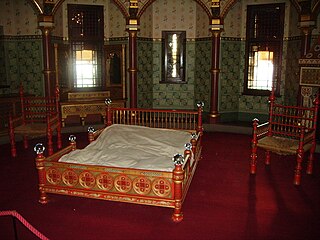
John Starling Chapple (1840–1922) was a stonemason and architect who worked as office manager for William Burges.
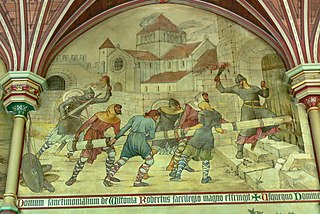
Horatio Walter Lonsdale (1846-1919) was an English painter and designer.
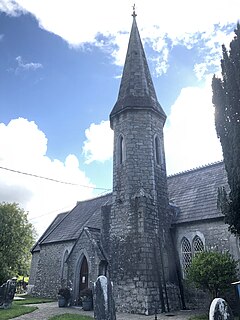
The Church of St Peter, Carrigrohane, is a Gothic Revival church in Cork, Ireland. It belongs to the Church of Ireland and was constructed in 1854, and extended by William Burges in 1865-68. The church is located on Church Hill, Carrigrohane, to the west of Cork city. It stands on the site of an earlier church, and is dedicated to Saint Peter. Along with the Church of the Resurrection and St Senan's Church it is part of the Carrigrohane Union of Parishes in the Diocese of Cork, Cloyne, and Ross.

Moira Forsyth was an English stained-glass artist. Her father was Gordon Forsyth a Scottish ceramics designer, stained-glass artist, and teacher. They both made impressive works for the St. Joseph's Church in Burslem, Stoke-on-Trent, Staffordshire. She made her name for her stained-glass works, such as those found at Guildford Cathedral, Norwich Cathedral and Eton College Chapel.
Herbert Hendrie was an English stained glass artist. He is known for his strong simple designs with scintillating jewel-like effects. Among his best-known works are the fifteen windows for Kippen church and the tall stained glass windows for Liverpool Cathedral.

William Wilson was a Scottish stained glass artist, printmaker and watercolour painter. He was a member of the Royal Scottish Academy. He was appointed an OBE.
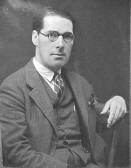
James Humphries Hogan RDI FSGT FRS was an English stained glass designer with the firm of James Powell and Sons throughout his career, rising from apprentice to be managing director of the company. He made magnificent stained glass for many of England's cathedrals, including the 100 feet high central windows of Liverpool Cathedral.

Frederick Weekes (1833-1920) was an English painter and designer. Son of the successful Victorian sculptor, Henry Weekes, two of his brothers also became artists, the genre and animal painters Herbert William Weekes and Henry Weekes Junior.
